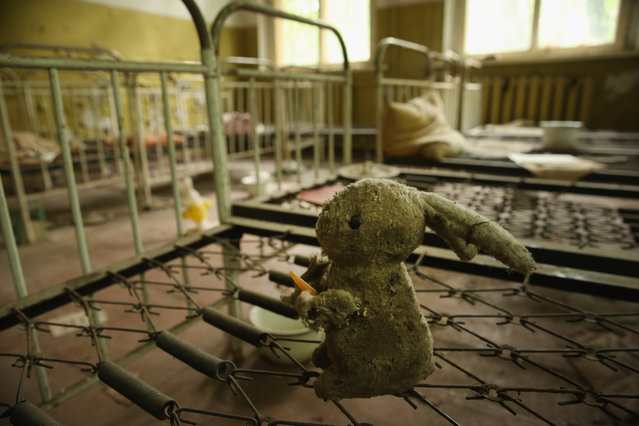
A stuffed rabbit doll sits among children's beds standing in the abandoned kindergarten of Kopachi village located inside the Chernobyl Exclusion Zone on September 29, 2015 near Chornobyl, Ukraine. Kopachi, a village that before 1986 had a population of 1,114, lies only a few kilometers south of the former Chernobyl nuclear power plant, where in 1986 workers inadvertantly caused reactor number four to explode, creating the worst nuclear accident in history. Radiation fallout was so high that authorities bulldozed and buried all of Kopachi's structures except for the kindergarten. Today the Kopachi site, which lies in the inner exclusion zone around Chernobyl where hot spots of persistently high levels of radiation make the area uninhabitable for thousands of years to come, is still contaminated with plutonium, cesium-137 and strontium-90. (Photo by Sean Gallup/Getty Images)
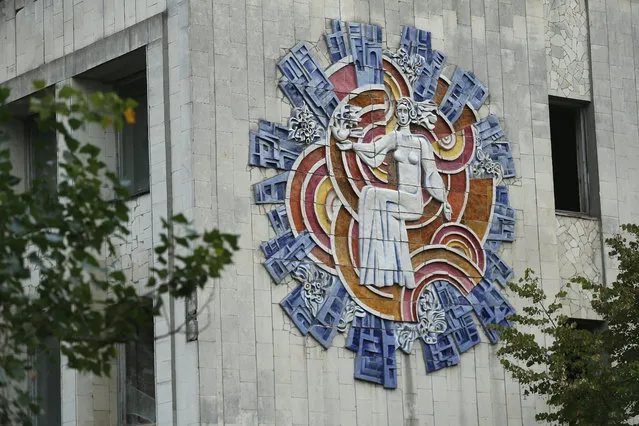
A mosaic decorates the facade of an abandoned post office on September 30, 2015 in Pripyat, Ukraine. Pripyat lies only a few kilometers from the former Chernobyl nuclear power plant and was built in the 1970s to house the plant's workers and their families. On April 26, 1986, technicians at Chernobyl conducting a test inadvertently caused reactor number four to explode, sending plumes of highly radioactive particles and debris into the atmosphere. Authorities evacuated 120,000 people from the area, including 43,000 from Pripyat. Today Pripyat is a ghost-town, its apartment buildings, shops, restaurants, hospital, schools, cultural center and sports facilities derelict and its streets overgrown with trees. The city lies in the inner exclusion zone around Chernobyl where hot spots of persistently high levels of radiation make the area uninhabitable for thousands of years to come. (Photo by Sean Gallup/Getty Images)
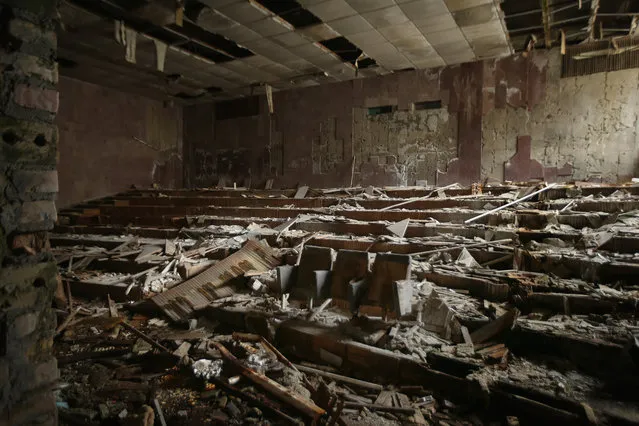
Rotting wooden chairs stand under a collapsed ceiling in the damp and abandoned auditorium of the “Energetika” cultural center on September 29, 2015 in Pripyat, Ukraine. (Photo by Sean Gallup/Getty Images)
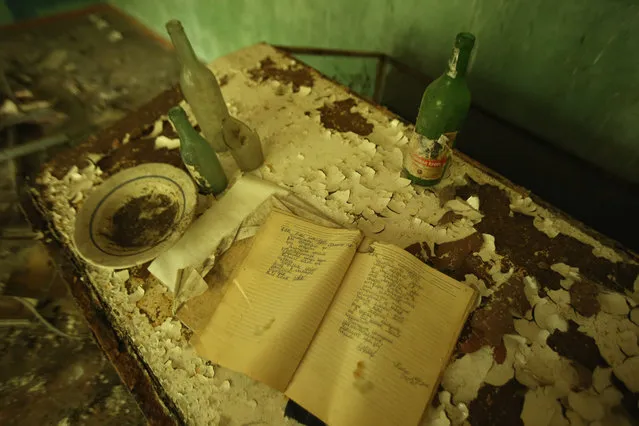
A notebook, beer bottles and plate lie on a flaking table in an abandoned house at Zalisya village located inside the Chernobyl Exclusion Zone on September 29, 2015 near Chornobyl, Ukraine. Zalisya, a village that before 1986 had a population of approximately 3,000, lies about 15 kilometers south of the former Chernobyl nuclear power plant, where in 1986 workers inadvertantly caused reactor number four to explode, creating the worst nuclear accident in history. Authorities evacuated 120,000 people, incuding the residents of Zalisya and 85 other villages, as well as of the towns of Chornobyl and Pripyat. Today the Zalisya site stands abandoned and overgrown with trees and vegetation. (Photo by Sean Gallup/Getty Images)
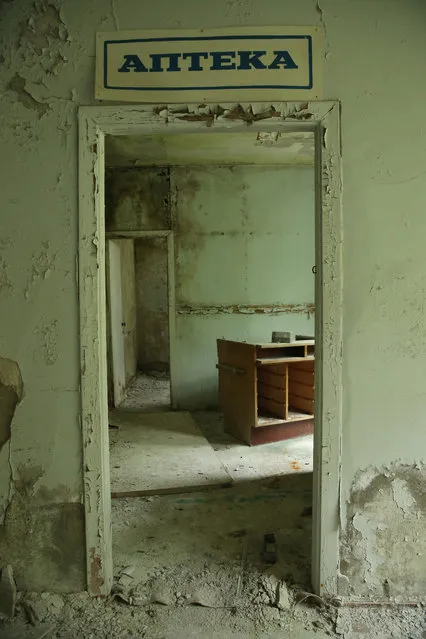
A sign marks the entrance to the pharmacy at the abandoned city hospital on September 30, 2015 in Pripyat, Ukraine. (Photo by Sean Gallup/Getty Images)
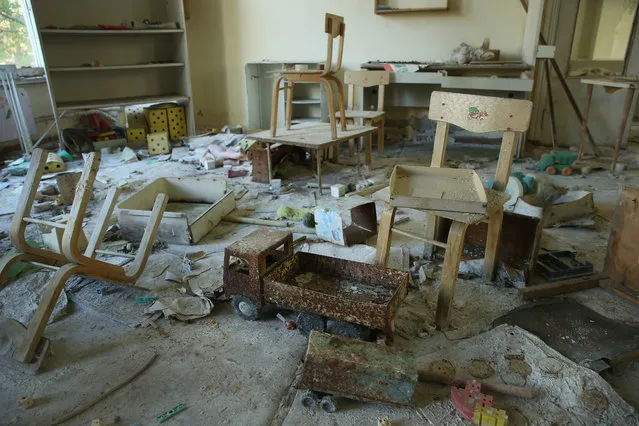
Toys and children's chairs lie in the “Zlataya ribka” (“Golden little fish”) abandoned kindergarten on September 30, 2015 in Pripyat, Ukraine. (Photo by Sean Gallup/Getty Images)
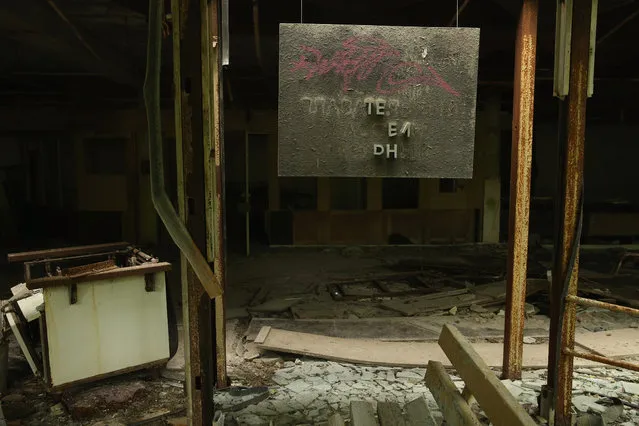
The remnants of a sign stand at the abandoned “Lazurna” public swimming pools facility on September 30, 2015 in Pripyat, Ukraine. (Photo by Sean Gallup/Getty Images)
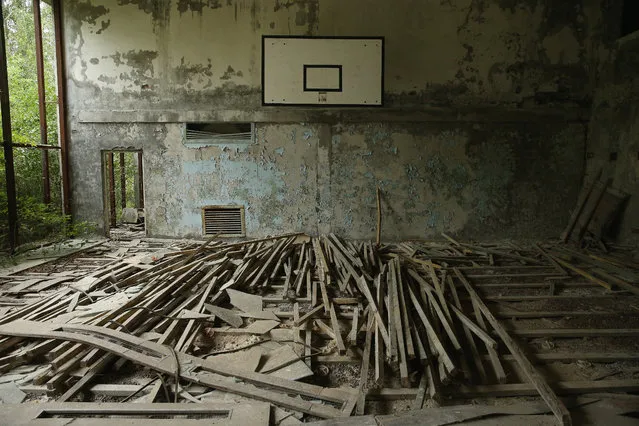
Floorboards lie in the former basketball court under peeling walls at the abandoned “Lazurna” public swimming pools facility on September 30, 2015 in Pripyat, Ukraine. (Photo by Sean Gallup/Getty Images)
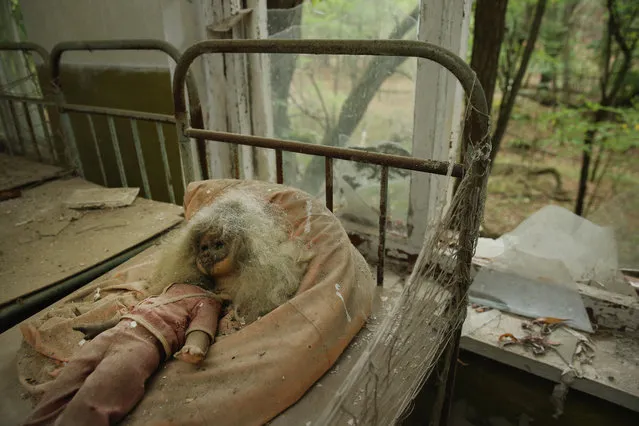
A doll lies among children's beds standing in the abandoned kindergarten of Kopachi village located inside the Chernobyl Exclusion Zone on September 29, 2015 near Chornobyl, Ukraine. (Photo by Sean Gallup/Getty Images)
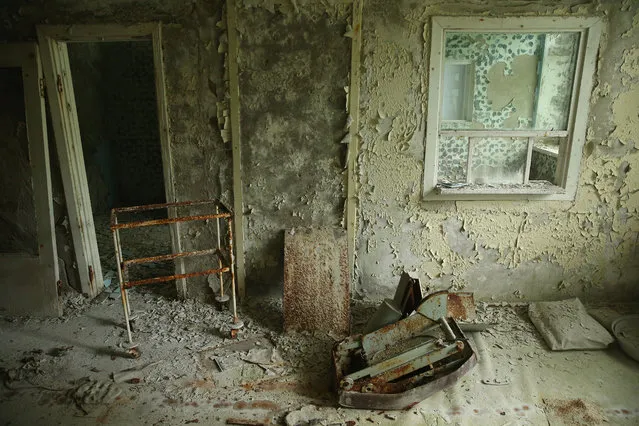
Rusting equipment lies among peeling walls in a room at the abandoned city hospital on September 30, 2015 in Pripyat, Ukraine. (Photo by Sean Gallup/Getty Images)
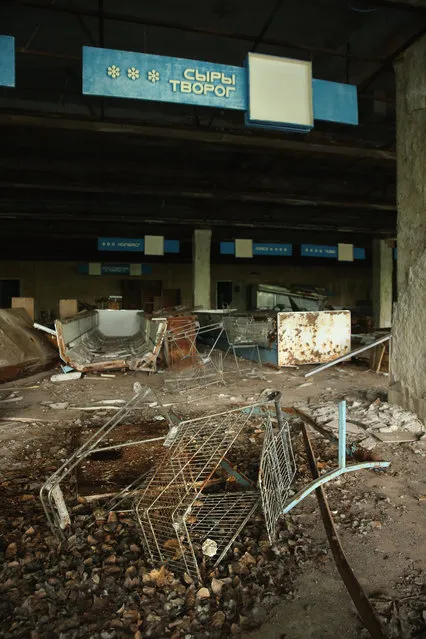
Rusting shopping carts and other debris litter the floor of an abandoned supermarket on September 30, 2015 in Pripyat, Ukraine. (Photo by Sean Gallup/Getty Images)
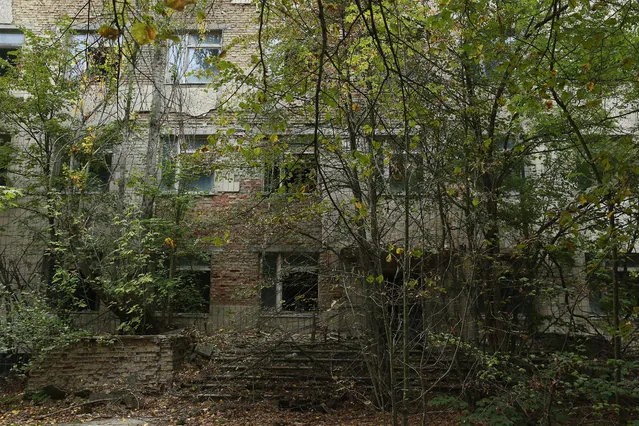
The entrance to the former city hospital stands nearly obscured by overgrown trees on September 30, 2015 in Pripyat, Ukraine. (Photo by Sean Gallup/Getty Images)
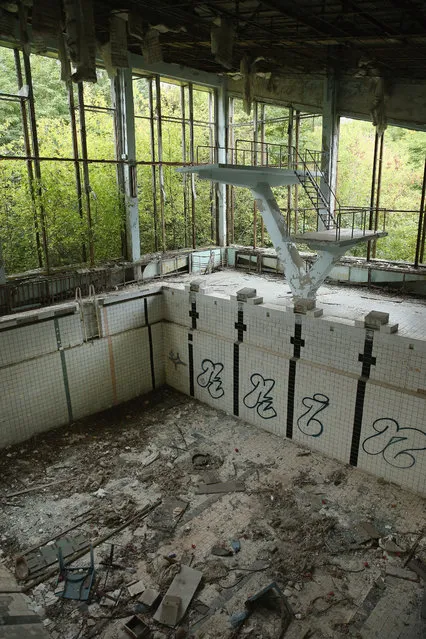
Diving boards stand over the remains of a pool at the abandoned “Lazurna” public swimming pools facility on September 30, 2015 in Pripyat, Ukraine. (Photo by Sean Gallup/Getty Images)
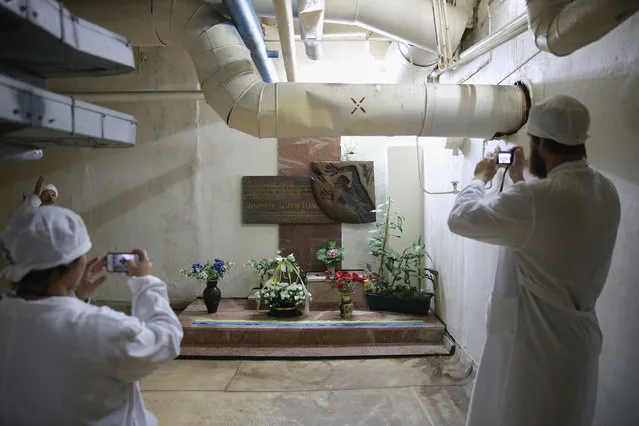
Visitors photograph a memorial to worker Valery Khodemchuk at a wall that separates reactors three and four inside the former Chernobyl nuclear power plant on September 29, 2015 near Chornobyl, Ukraine. Khodemchuk was a circulating pump operator killed in the accident at reactor four and his body remains entombed inside the reactor four site. On April 26, 1986, technicians at Chernobyl conducting a test inadvertently caused reactor number four, which contained over 200 tons of uranium, to explode, flipping the 1,200 ton lid of the reactor into the air and sending plumes of highly radioactive particles and debris into the atmosphere in a deadly cloud that reached as far as western Europe. 32 people, many of them firemen sent to extinguish the blaze, died within days of the accident, and estimates vary from 4,000 to 200,000 deaths since then that can be attributed to illnesses resulting from Chernobyl's radioactive contamination. Today large portions of the inner and outer Chernobyl Exclusion Zone that together cover 2,600 square kilometers remain contaminated. A consortium of western companies is building a movable enclosure called the New Safe Confinement that will cover the reactor remains and its fragile sarcophagus in order to prevent further contamination. (Photo by Sean Gallup/Getty Images)
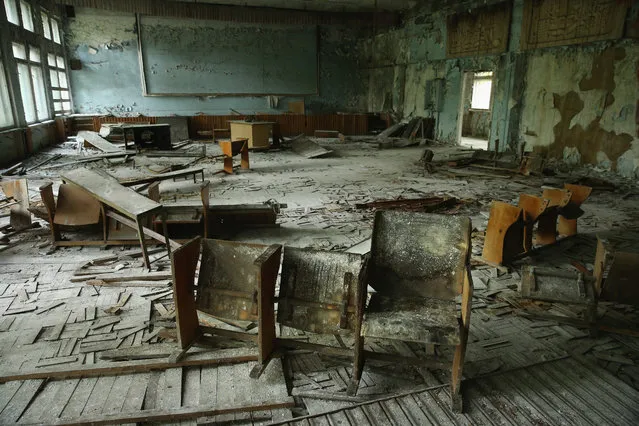
Pupils' chairs stand on rotting floorboards in an auditorium of abandoned School Number 3 on September 30, 2015 in Pripyat, Ukraine. (Photo by Sean Gallup/Getty Images)
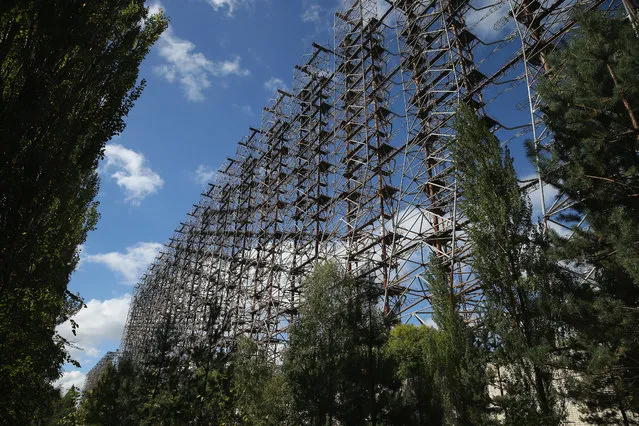
An abandoned Soviet Cold War-era radar system known as “The Woodpecker” used to detect incoming missiles and that measures 140 meters tall stands inside the Chernobyl Exclusion Zone on September 30, 2015 near Chornobyl, Ukraine. The Chernobyl Exclusion Zone is a 2,600 square kilometer restricted access zone established in the contaminated area around the Chernobyl nuclear power plant. On April 26, 1986, technicians at Chernobyl conducting a test inadvertently caused reactor number four to explode, creating the worst nuclear accident in history. Authorities evacuated 120,000 people from surrounding towns and villages. While workers employed at the Chernobyl site today and a small number of returnees live in the outer zone, no one is allowed to live in the inner zone, where hot spots of radiation make the area uninhabitable for thousands of years to come. (Photo by Sean Gallup/Getty Images)
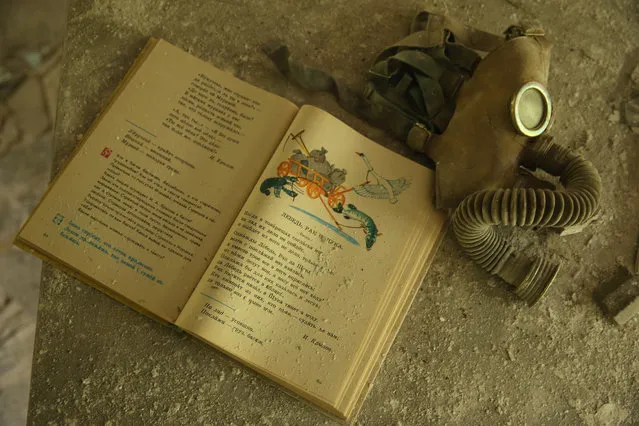
A schoolbook lies on a pupils' desk next to a Cold War-era gas mask in a classroom of abandoned School Number 3 on September 30, 2015 in Pripyat, Ukraine. (Photo by Sean Gallup/Getty Images)
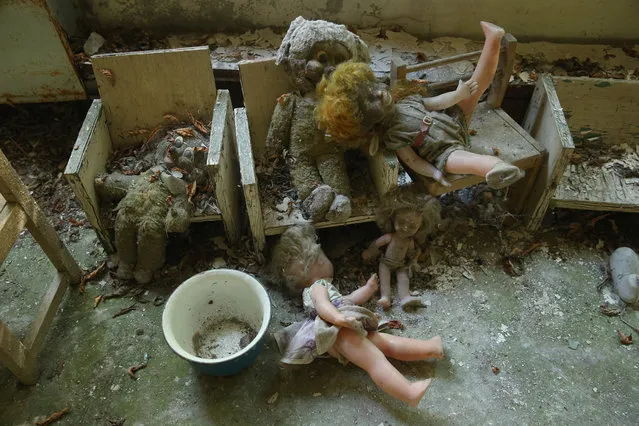
Dolls and stuffed animals lie in the “Zlataya ribka” (“Golden little fish”) abandoned kindergarten on September 30, 2015 in Pripyat, Ukraine. (Photo by Sean Gallup/Getty Images)
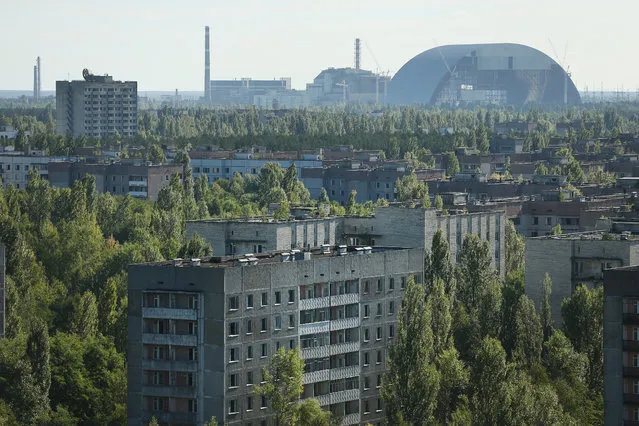
The former Chernobyl nuclear power plant, including destroyed reactor four (C), as well as the New Safe Confinement structure (R) that will one day enclose the remains of reactor four, stand behind the abandoned city of Pripyat on September 30, 2015 near Pripyat, Ukraine. (Photo by Sean Gallup/Getty Images)
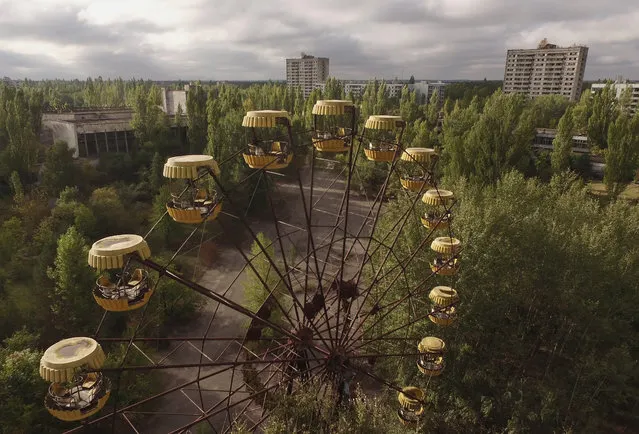
In this aerial view an abandoned ferris wheel stands on a public space overgrown with trees in the former city center on September 30, 2015 in Pripyat, Ukraine. (Photo by Sean Gallup/Getty Images)

A Soviet-era hammer and sickle adorned with a Ukrainian flag stands on top of an abandoned apartment building on September 30, 2015 in Pripyat, Ukraine. (Photo by Sean Gallup/Getty Images)
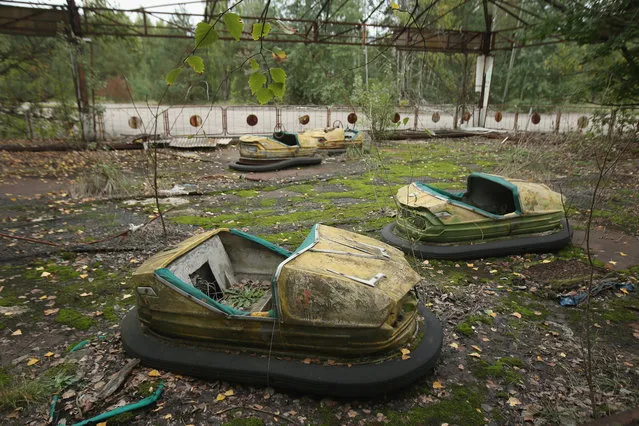
Bumper cars stand in an abandoned amusement park on September 29, 2015 in Pripyat, Ukraine. (Photo by Sean Gallup/Getty Images)
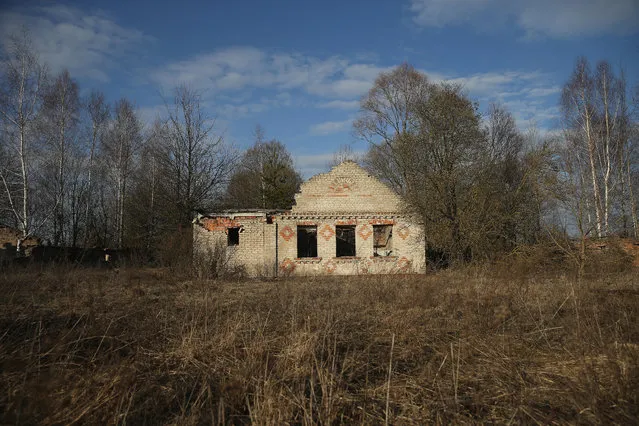
The remains of a house stand at the site of the raized village of Akshynka on April 4, 2016 near Chachersk, Belarus. Akshynka was among hundreds of villages in Belarus demolished by authorities and the residents evacuated following radiation contamination from the Chernobyl nuclear disaster in 1986. Chachersk, located in south-eastern Belarus, is in a zone designated as still contaminated to varying degrees with Chernobyl radiation, especially caesium-137. Numerous areas nearby are off-limits to visitors and signs on the edges of forests warn of radiation and urge people not to pick berries and mushrooms. While the United Nations Scientific Committee on the Effects of Radiation (UNSCEAR) claims that Chernobyl radiation in the region no longer poses a significant health risk, local physicians and researchers say the ongoing threat is still very real and that a dramatically high rate of children are born with weak immune systems and heart rhythm disorders. According to the Belarus government it currently spends 5% of its annual budget dealing with the consequences of Chernobyl and 20% of arable land in Belarus remains too contaminated for use. (Photo by Sean Gallup/Getty Images)
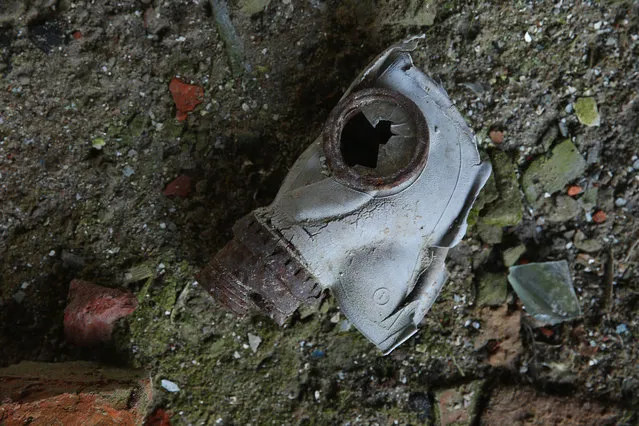
A gas mask lies on the floor of the ruins of a building at the site of the raized village of Akshynka on April 4, 2016 near Chachersk, Belarus. (Photo by Sean Gallup/Getty Images)

An icon hangs among the ruins of one of the few remaining structures at the site of the raized village of Navilovka on April 4, 2016 near Chachersk, Belarus. Navilovka was among hundreds of villages in Belarus demolished by authorities and the residents evacuated following radiation contamination from the Chernobyl nuclear disaster in 1986. Chachersk, located in south-eastern Belarus, is in a zone designated as still contaminated to varying degrees with Chernobyl radiation, especially caesium-137. Numerous areas nearby are off-limits to visitors and signs on the edges of forests warn of radiation and urge people not to pick berries and mushrooms. While the United Nations Scientific Committee on the Effects of Radiation (UNSCEAR) claims that Chernobyl radiation in the region no longer poses a significant health risk, local physicians and researchers say the ongoing threat is still very real and that a dramatically high rate of children are born with weak immune systems and heart rhythm disorders. According to the Belarus government it currently spends 5% of its annual budget dealing with the consequences of Chernobyl and 20% of arable land in Belarus remains too contaminated for use. (Photo by Sean Gallup/Getty Images)
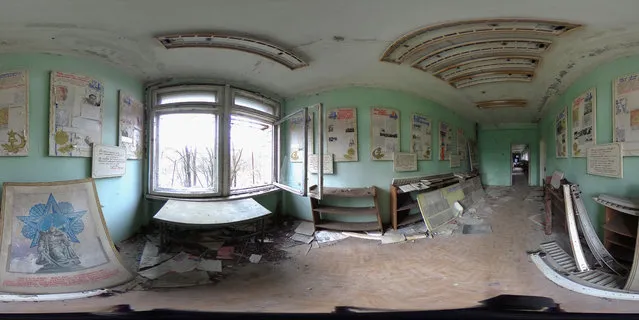
Posters in Russian hang from the wall of a room in elementary school number three on April 9, 2016 in Pripyat, Ukraine. (Photo by Sean Gallup/Getty Images)
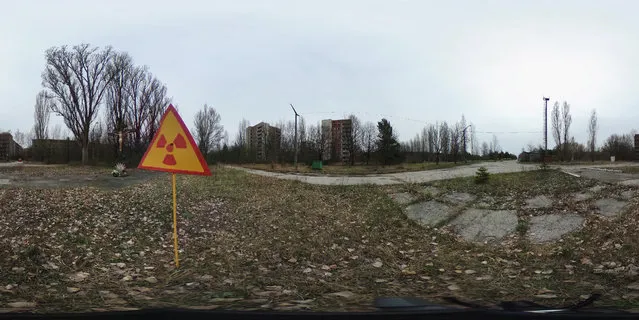
A sign warning of radiation contamination stands near former apartment buildings on April 9, 2016 in Pripyat, Ukraine. Pripyat, built in the 1970s as a model Soviet city to house the workers and families of the Chernobyl nuclear power plant, now stands abandoned inside the Chernobyl Exclusion Zone, a restricted zone contaminated by radiation from the 1986 meltdown of reactor number four at the nearby Chernobyl plant in the world's worst civilian nuclear accident that spewed radiaoactive fallout across the globe. Authorities evacuated approximately 43,000 people from Pripyat in the days following the disaster and the city, with its high-rise apartment buildings, hospital, shops, schools, restaurants, cultural center and sports facilities, has remained a ghost-town ever since. The world will soon commemorate the 30th anniversary of the April 26, 1986 Chernobyl disaster. (Photo by Sean Gallup/Getty Images)
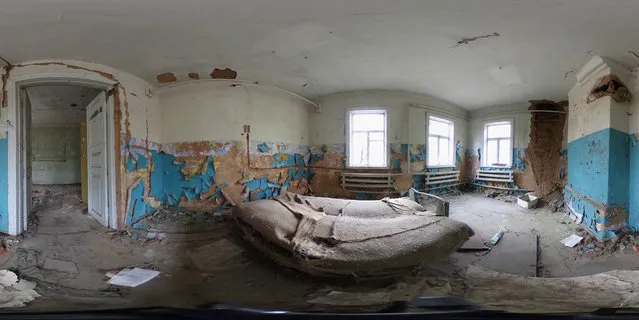
A bed stands in a room in an abandoned house on April 9, 2016 in Zalissya, Ukraine. Zalissya, once a village of several hundred households, stands inside the Chernobyl Exclusion Zone, a restricted zone contaminated by radiation from the 1986 meltdown of reactor number four at the Chernobyl nuclear power plant in the world's worst civilian nuclear accident that spewed radiaoactive fallout across the globe. Approximately 90 villages inside the zone were evacuated and abandoned due to the accident. The world will soon commemorate the 30th anniversary of the April 26, 1986 Chernobyl disaster. (Photo by Sean Gallup/Getty Images)
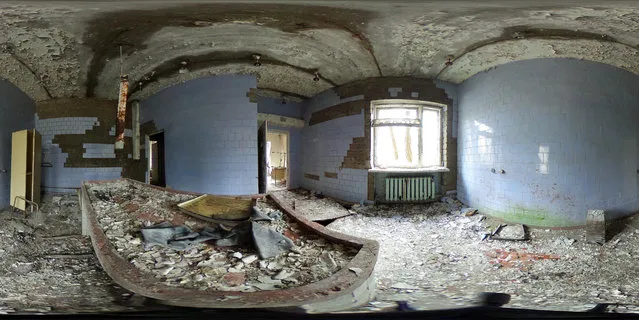
Plastic gloves lie on an examining table in a former morgue on April 9, 2016 in Pripyat, Ukraine. (Photo by Sean Gallup/Getty Images)
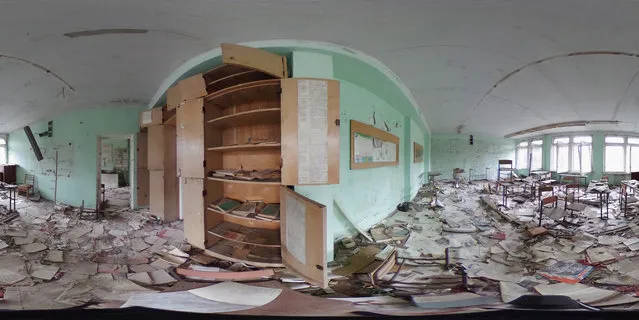
Books lie strewn across the floor in a former classroom in elementary school number three on April 9, 2016 in Pripyat, Ukraine. (Photo by Sean Gallup/Getty Images)
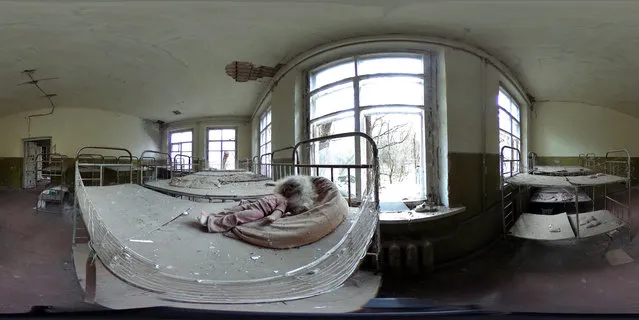
A blackened doll lies on a bed in an abandoned kindergarten on April 9, 2016 in Kopachi, Ukraine. (Photo by Sean Gallup/Getty Images)
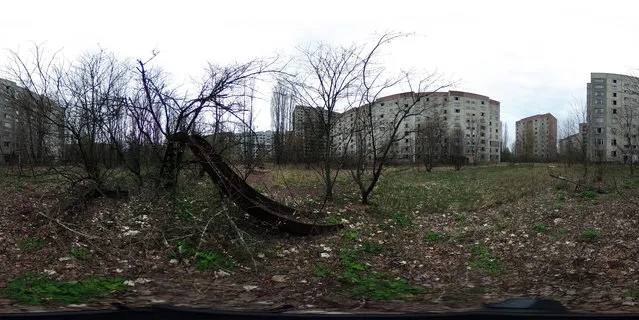
A children's slide stands among former apartment buildings on April 9, 2016 in Pripyat, Ukraine. (Photo by Sean Gallup/Getty Images)
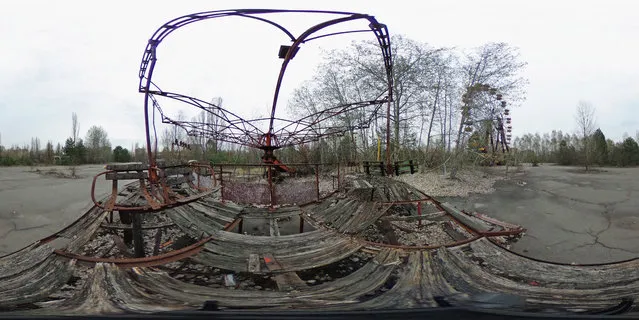
A rusting merry-go-round stands on April 9, 2016 in Pripyat, Ukraine. (Photo by Sean Gallup/Getty Images)

A rusting ferris wheel and ticket booth stand on April 9, 2016 in Pripyat, Ukraine. (Photo by Sean Gallup/Getty Images)
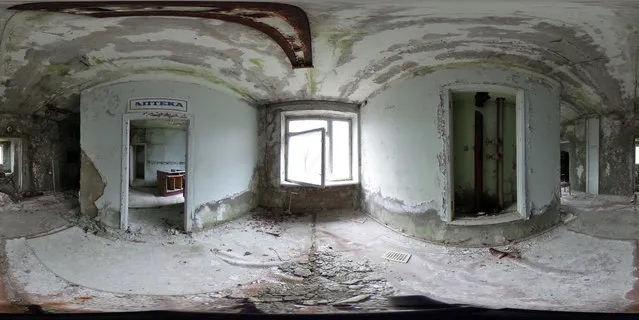
A sign over a door reads: “Pharmacy” in the crumbling former hospital on April 9, 2016 in Pripyat, Ukraine. (Photo by Sean Gallup/Getty Images)
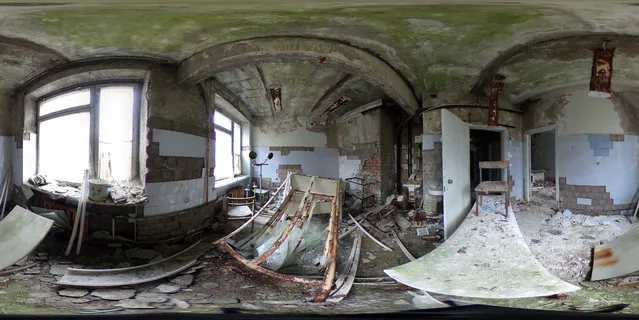
Rusting medical equipment stands in a room in the crumbling former hospital on April 9, 2016 in Pripyat, Ukraine. (Photo by Sean Gallup/Getty Images)
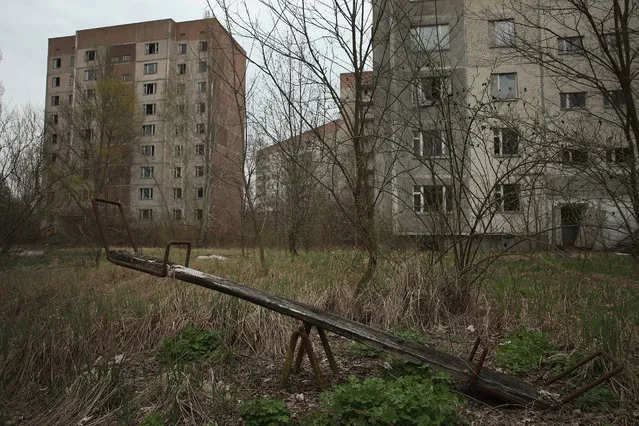
A children's seesaw stands among former apartment buildings on April 9, 2016 in Pripyat, Ukraine. (Photo by Sean Gallup/Getty Images)
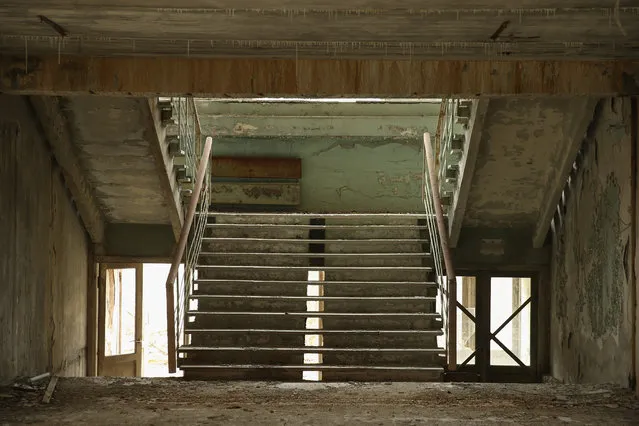
A stairwell stands in abandoned elementary school number five on April 9, 2016 in Pripyat, Ukraine. (Photo by Sean Gallup/Getty Images)
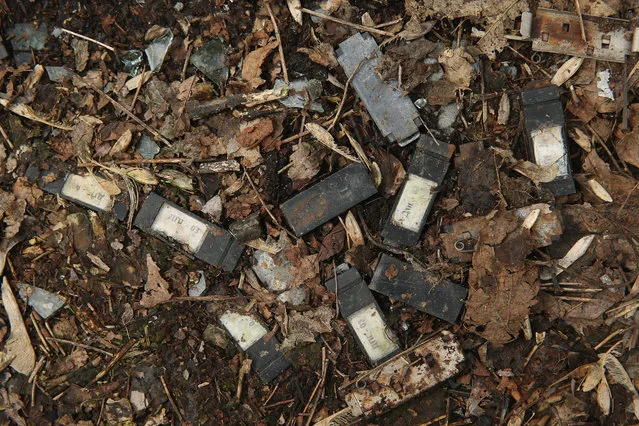
Small dosimeters that measure radiation dosage and used by emergency workers following the Chernobyl nuclear disaster lie scattered on the ground outside on April 9, 2016 in Pripyat, Ukraine. (Photo by Sean Gallup/Getty Images)
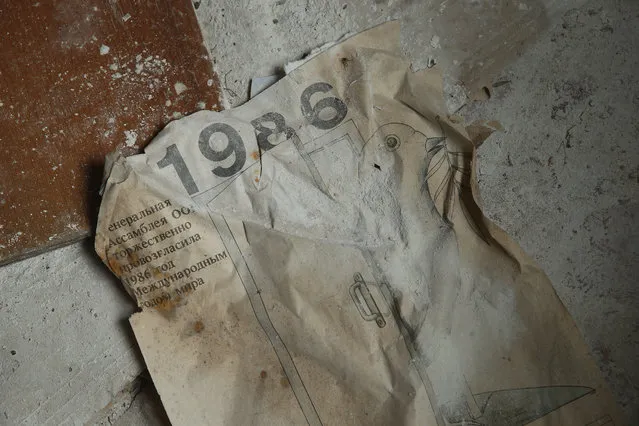
A calendar from the fateful year 1986 lies on the floor of a former hospital on April 9, 2016 in Pripyat, Ukraine. (Photo by Sean Gallup/Getty Images)
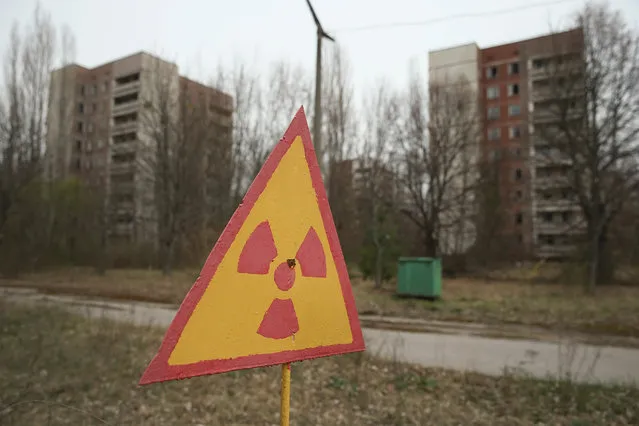
A sign warns of radiation contamination near former apartment buildings on April 9, 2016 in Pripyat, Ukraine. (Photo by Sean Gallup/Getty Images)
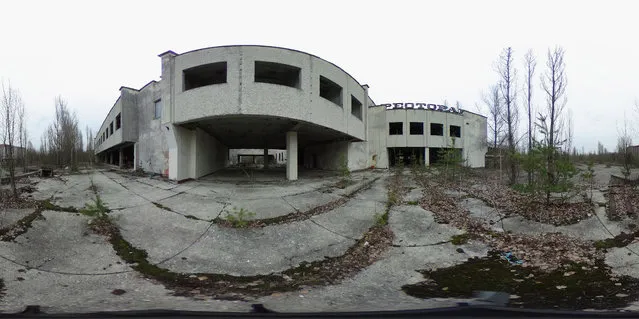
A former restaurant stands at the main square on April 9, 2016 in Pripyat, Ukraine. (Photo by Sean Gallup/Getty Images)
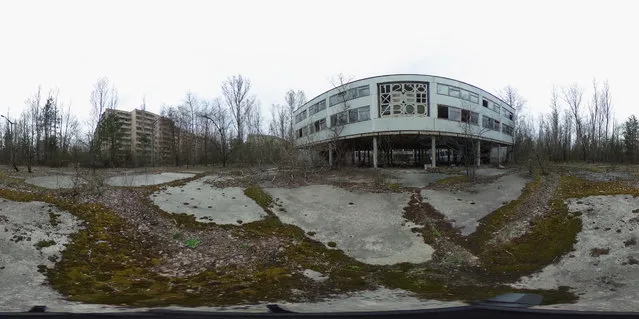
Former elementary school number three stands near apartment blocks on April 9, 2016 in Pripyat, Ukraine. (Photo by Sean Gallup/Getty Images)
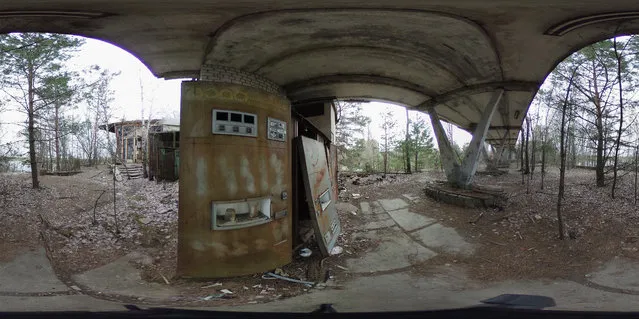
A rusting vending machine stands next to a former river-front cafe on April 9, 2016 in Pripyat, Ukraine. (Photo by Sean Gallup/Getty Images)
27 Apr 2016 09:28:00,
post received
0 comments
